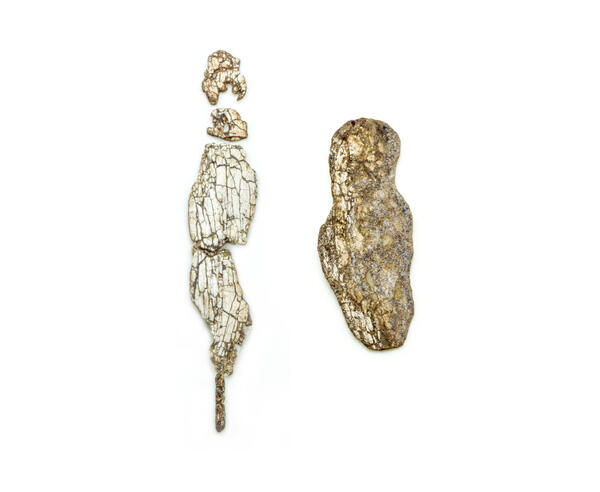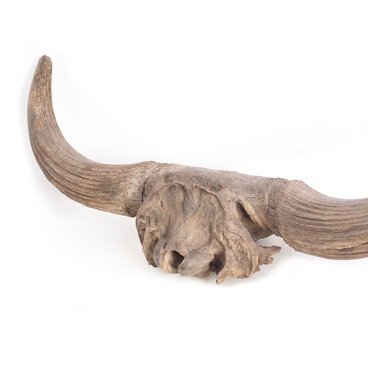Two mammoth tusk figurines were found at the excavations of the archaeological monument Kovrizhka 4. The complex got its name in honor of a rock nearby. It was discovered by researcher Alexey Tetenkin in the Bodaibinsky district of the Irkutsk region, on the bank of the Vitim River in 2004.
On the Kovrizhka 4, the researchers identified more than 15 levels on which ancient artifacts were deposited. The sixth layer is of particular interest. Here crafts were found that are now stored in the collection of the regional museum of local history.
The first figurine — scientists named it ‘Vitimochka’ — was found 800 meters from the central fire pit. She was lying ‘head’ to the east. From the shape of its neck, torso, legs and other parts of the ‘body’, the researchers assumed it was a female figure. Today, ‘Vitimochka’ is one of the rare and valuable finds of ancient art in the territory of North-Eastern Siberia and the only human figurine of the Late Paleolithic era (10-45 thousand years ago) that was found in the region.
The second piece only in general terms resembled the silhouette of a person. There were no traces of engraving on it, but archaeologists found a cluster of pieces of ochre in the ‘headboard’ of the figure — most likely, it was used in ancient rituals. Both figurines were created from bone plates, the thickness of which did not exceed two millimeters.
The findings of Irkutsk archaeologists were confirmed by Olga Zhmur, head of Restoration and Conservation laboratory at the Peter the Great Museum of Anthropology and Ethnography (the Kunstkamera) in St. Petersburg. She examined the figurines and came to the conclusion that these are images of people.
Using radiocarbon analysis, Alexey Tetenkin determined the age of the dwelling and objects in the Kovrizhka 4 dwelling site is 19 thousand years. Handicrafts made from a mammoth tusk, along with other finds, revealed to archaeologists the Paleolithic art of the inhabitants of the Baikal-Patomsky highlands and the Vitim basin.
In the 2010s, there were not only Irkutsk specialists but also their French and American colleagues working on the archaeological site: Jeremy Jacquier, Aured Henri and others. Excavations at the ‘Kovrizhka 4’ dwelling site continue to this day.
On the Kovrizhka 4, the researchers identified more than 15 levels on which ancient artifacts were deposited. The sixth layer is of particular interest. Here crafts were found that are now stored in the collection of the regional museum of local history.
The first figurine — scientists named it ‘Vitimochka’ — was found 800 meters from the central fire pit. She was lying ‘head’ to the east. From the shape of its neck, torso, legs and other parts of the ‘body’, the researchers assumed it was a female figure. Today, ‘Vitimochka’ is one of the rare and valuable finds of ancient art in the territory of North-Eastern Siberia and the only human figurine of the Late Paleolithic era (10-45 thousand years ago) that was found in the region.
The second piece only in general terms resembled the silhouette of a person. There were no traces of engraving on it, but archaeologists found a cluster of pieces of ochre in the ‘headboard’ of the figure — most likely, it was used in ancient rituals. Both figurines were created from bone plates, the thickness of which did not exceed two millimeters.
The findings of Irkutsk archaeologists were confirmed by Olga Zhmur, head of Restoration and Conservation laboratory at the Peter the Great Museum of Anthropology and Ethnography (the Kunstkamera) in St. Petersburg. She examined the figurines and came to the conclusion that these are images of people.
Using radiocarbon analysis, Alexey Tetenkin determined the age of the dwelling and objects in the Kovrizhka 4 dwelling site is 19 thousand years. Handicrafts made from a mammoth tusk, along with other finds, revealed to archaeologists the Paleolithic art of the inhabitants of the Baikal-Patomsky highlands and the Vitim basin.
In the 2010s, there were not only Irkutsk specialists but also their French and American colleagues working on the archaeological site: Jeremy Jacquier, Aured Henri and others. Excavations at the ‘Kovrizhka 4’ dwelling site continue to this day.



